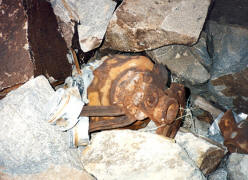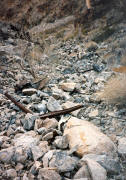|
|
 |
 |
| A Boeing B-17 Flying Fortress | Bud & Ann Richell shortly before the crash. |
B-17G Flying Fortress #42-97619, crashed on June 28, 1944, Telegraph Pass, Yuma, Arizona
Summary: The B-17 bomber departed Yuma Army Airfield just after midnight for a round-robin night navigation training flight. The crew consisted of an instructor pilot, two copilots in training, a flight engineer, and a crew chief. At 1:42 am, 2nd Lt. William Richell radioed the tower at Yuma AAF to request landing instructions. Ten minutes later, a few witnesses 20 miles east of Yuma saw a massive fireball as the bomber impacted the top of the of the Gila Mountains. Although it is unknown who was in control of the bomber at the time of the crash, it was thought by investigators that the pilot had been using the lights of Yuma as a navigational aid, and inadvertently let the bomber descend too low before the city lights became obscured by the ridge the plane impacted. Most of the debris from the bomber remains today, but six decades of rockslides and steep terrain have covered up much of the wreckage. I spoke with Bud Richell's brother, Fred, who was only 15 years old when his 22 year old brother was killed in the crash. He recalled the last time he saw Bud was when he came home on furlough in upstate New York, only three weeks before he died. Bud had just left Roswell AAB in New Mexico where he had completed his 4-engine training before being assigned to Yuma. Bud had told Fred that he loved flying, but the one thing that bothered him was flying at night. The crew members were: 2nd Lt's William Richell, Angus MacArthur and Sheridan Marek, Sergeant Manteu Jones, and Corporal Merle Ice. |
 |
 |
 |
 |
| A supercharger. | Landing gear and supercharger. | Landing gear wheel. | A smashed engine. |
 |
 |
|
|
| Crankshaft and piston buried under rocks. | Looking down the steep ravine. | "Model No. B-17G" This tag was mounted on a bulkhead in the tail section. | A crushed flight instrument. |
|
|
|
|
|
| Data plate from the auxiliary power unit. | Cockpit instrument faces. | Headphone speakers | The backside of one. |
|
|
|
|
 |
| A fuel selector valve. | The handle/ trigger to a fire extinguisher. | The tail gunner's gun sight for the twin .50s. | Note the tail gunner's gun sight. |